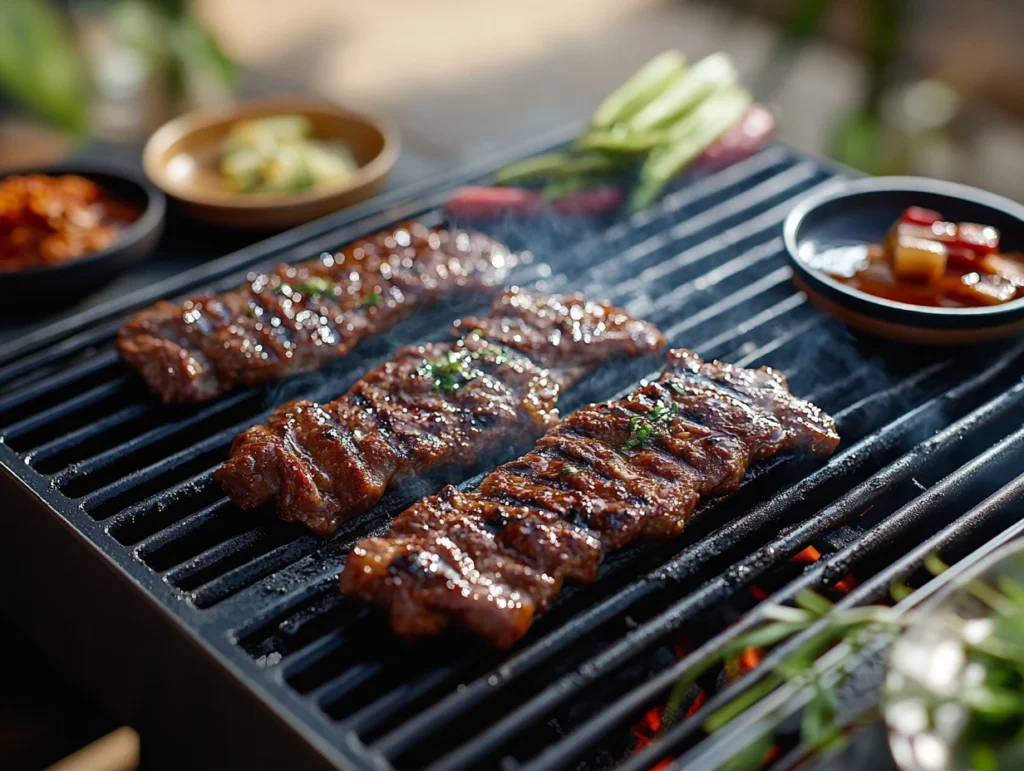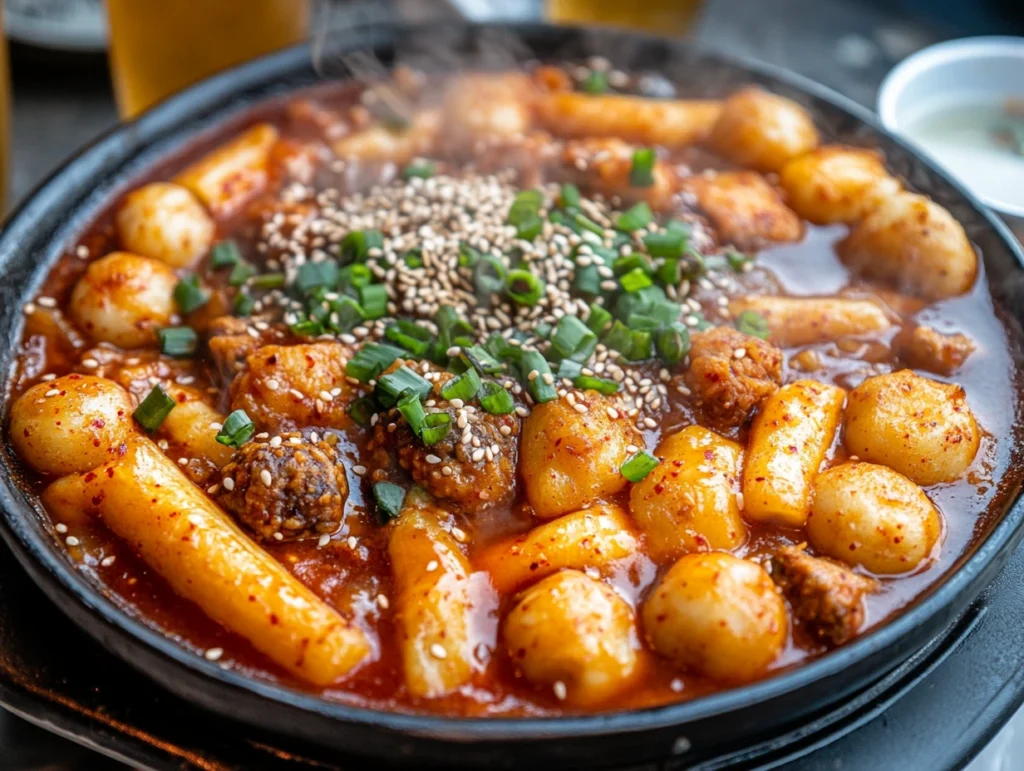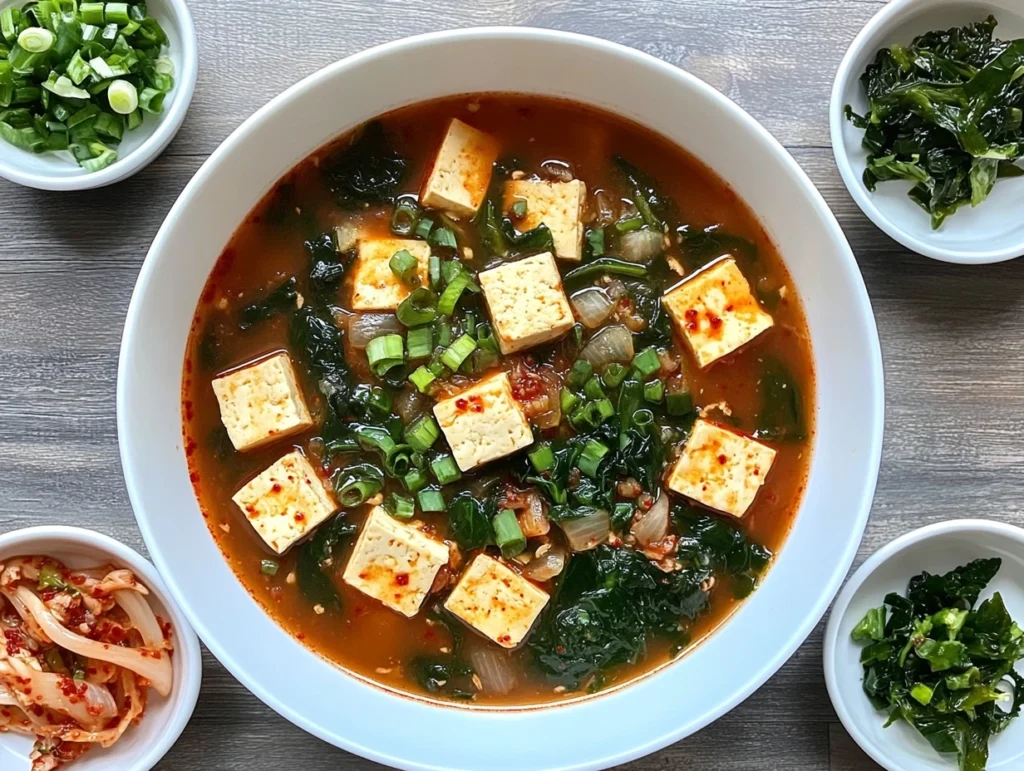Introduction to Korean Cuisine
Korean cuisine is a celebration of bold flavors, vibrant ingredients, and time-honored traditions. Known for its emphasis on fermented foods, fresh vegetables, and balanced flavors, Korean cooking reflects a deep cultural appreciation for harmony. With its rich history, Korean food offers a wide variety of dishes, each offering a unique experience—from the smoky, savory delights of Korean BBQ to the comforting warmth of stews. It is this diversity of flavors, textures, and techniques that has contributed to the global rise of Korean cuisine.
Over recent years, Korean food has gained immense popularity worldwide, thanks to the booming success of Korean BBQ and iconic dishes like kimchi and bibimbap. The rise of Korean street food, from crispy fried chicken to spicy rice cakes, has only further solidified its place in global food culture. Whether you’re enjoying a sizzling plate of bulgogi, slurping up a bowl of spicy kimchi jjigae, or enjoying some crunchy kimbap, Korean recipes are both comforting and exhilarating.
In this article, we aim to take you on a culinary adventure with 35 easy and authentic Korean recipes that are simple to make in your own kitchen. Whether you’re a seasoned home cook or a beginner looking to explore new flavors, these recipes will introduce you to the bold, umami-packed world of Korean cuisine. From Korean BBQ to noodle dishes and traditional stews, you’ll find something for every taste and occasion. For more tips on authentic Korean cooking techniques, check out our detailed guide to get started!
The Essential Ingredients for Korean recipes Cooking
To successfully make Korean recipes at home, you’ll need to stock up on some essential ingredients. Korean cuisine is known for its unique flavors, many of which come from fermented foods and distinct seasonings. Let’s take a look at some of the key ingredients that you’ll encounter in Korean recipes.
Key Korean Ingredients
- Gochujang (Korean chili paste): A sweet, spicy, and savory fermented condiment made from chili peppers, rice, and fermented soybeans. It’s a must-have in dishes like bibimbap and kimchi jjigae.
- Gochugaru (Korean chili flakes): These coarse chili flakes have a smoky heat, often used to flavor kimchi and soups.
- Sesame oil: This nutty oil adds a rich, toasty flavor to everything from stir-fries to soups.
- Soy sauce: Essential in Korean cooking, soy sauce adds saltiness and depth to marinades, stews, and stir-fries.
- Rice vinegar: A mild, slightly sweet vinegar used to balance out flavors in pickled vegetables and salad dressings.
- Doenjang (fermented soybean paste): This thick, earthy paste is used in soups and stews for a savory depth of flavor.
- Kimchi: The quintessential Korean dish, kimchi is made from fermented cabbage and radishes, flavored with gochugaru, garlic, and ginger.
- Rice (particularly short-grain rice): Served with nearly every meal, rice is a cornerstone of Korean cuisine.
Korean Cooking Staples
- Tofu: Frequently used in stews and stir-fries, tofu is a popular protein source in Korean vegetarian recipes.
- Korean vegetables: Vegetables such as napa cabbage (used in kimchi), Korean radish (mu), and spinach are essential to many dishes.
- Noodles: Glass noodles (made from sweet potato starch) are commonly used in dishes like Japchae, while wheat noodles are used for Jajangmyeon.
Where to Find Korean Ingredients
Finding these ingredients can be a challenge, depending on where you live. Luckily, most large grocery stores have an international section where you can find basics like soy sauce, sesame oil, and rice. However, for more specific items like gochujang or doenjang, consider visiting an Asian or Korean supermarket. If you don’t have access to one locally, many online retailers and specialty stores offer Korean ingredients, so you can easily stock up on what you need.
35 Easy & Authentic Korean Recipes
Now that you know the ingredients, it’s time to dive into the recipes! Here are 35 easy and authentic Korean dishes that you can try at home. We’ve divided the recipes into categories: Korean BBQ, Korean Noodles, Korean Soups & Stews, Korean Snacks & Street Food, and Korean Vegetarian Dishes.
A. Korean recipes BBQ Dishes
Korean BBQ is a vibrant and communal dining experience that has captivated food lovers around the world. It’s all about marinated meats, grilled to perfection, and enjoyed with a variety of banchan (side dishes). Here are some simple yet delicious Korean BBQ dishes that you can easily prepare at home.
Bulgogi (Korean BBQ Beef)

Bulgogi is one of the most popular Korean BBQ dishes. It’s made from thinly sliced beef marinated in a mixture of soy sauce, sesame oil, garlic, and sugar. This marinade gives the beef a perfect balance of savory and sweet flavors, and when grilled or pan-fried, the meat becomes tender and flavorful.
Ingredients:
- 1 lb thinly sliced beef (sirloin or rib-eye)
- 1/4 cup soy sauce
- 2 tbsp sesame oil
- 2 tbsp brown sugar
- 3 cloves garlic, minced
- 1/2 onion, sliced
- 1 tbsp sesame seeds
- 1 tsp black pepper
Instructions:
- Combine soy sauce, sesame oil, brown sugar, garlic, onion, sesame seeds, and pepper in a bowl. Add the beef slices and mix well. Marinate for at least 30 minutes (or up to 4 hours).
- Heat a grill or pan over medium-high heat. Cook the marinated beef for about 2-3 minutes per side, or until browned and cooked through.
- Serve with steamed rice and a side of kimchi.
Tips: Marinating the beef longer results in better flavor. For added flavor, try grilling the beef on a charcoal grill.
Samgyeopsal (Grilled Pork Belly)
Another popular BBQ dish is samgyeopsal, or grilled pork belly. The pork is typically grilled at the table, allowing everyone to enjoy the cooking process. Serve it with lettuce wraps and a dipping sauce for an authentic experience.
Galbi (Korean Short Ribs)
Galbi are tender, marinated short ribs cooked on the grill. The marinade is similar to bulgogi, with soy sauce, sesame oil, garlic, and sugar, but it also includes pear or apple juice for added sweetness. Serve with a side of rice and banchan for a complete meal.
B. Korean recipes Noodles
Korean noodles are known for their chewy texture and versatility. Whether served in a hot, savory broth or stir-fried with vegetables, these noodle dishes are a comforting addition to any meal.
Japchae (Korean Stir-Fried Glass Noodles)
Japchae is a stir-fried noodle dish made with chewy glass noodles, vegetables, and a sweet soy-based sauce. It’s often served as a side dish but can also be enjoyed as a main course.
Ingredients:
- 8 oz glass noodles (dangmyeon)
- 1/2 onion, sliced
- 1/2 carrot, julienned
- 1/2 bell pepper, sliced
- 1 cup spinach
- 2 tbsp soy sauce
- 1 tbsp sesame oil
- 1 tsp sugar
- 1 tbsp sesame seeds
Instructions:
- Cook the glass noodles according to package instructions. Drain and set aside.
- Stir-fry the vegetables (onion, carrot, bell pepper) in a pan until tender.
- Add the cooked noodles to the vegetables, along with soy sauce, sesame oil, and sugar. Stir-fry for 2-3 minutes.
- Top with sesame seeds and serve.
Tips: For a protein boost, add some beef, chicken, or tofu to the dish.
[Link to: Korean noodle recipes]
Jajangmyeon (Korean Black Bean Paste Noodles)
Jajangmyeon is a savory noodle dish made with a rich black bean paste sauce. It’s hearty and comforting, perfect for a filling meal.
C. Korean Soups & Stews
Korean soups and stews are perfect for colder weather, providing warmth and comfort. Many of these dishes feature hearty broths and savory ingredients like tofu, seafood, and kimchi.
Kimchi Jjigae (Kimchi Stew)
Kimchi jjigae is a classic Korean stew made with kimchi, tofu, and pork or beef. It’s spicy, tangy, and comforting—a perfect dish for colder months.
Ingredients:
- 1 cup kimchi, chopped
- 1/2 lb pork belly or tofu
- 2 cups water
- 1 tbsp gochujang (Korean chili paste)
- 1 tbsp soy sauce
- 2 cloves garlic, minced
Instructions:
- Sauté the pork belly (or tofu) in a pot until browned.
- Add the chopped kimchi and stir-fry for 2-3 minutes.
- Add water, gochujang, soy sauce, and garlic. Bring to a boil, then simmer for 15-20
D. Korean Snacks & Street Food
Korean street food is renowned for its delicious, portable snacks that are both satisfying and flavorful. These snacks are often enjoyed on the go and feature a variety of tastes, from spicy and savory to sweet and crispy.
Tteokbokki (Spicy Rice Cakes)
Tteokbokki is a beloved Korean street food made with chewy rice cakes and a spicy, sweet sauce. This dish is often served as a snack or quick meal, with its irresistible combination of flavors.
Ingredients:
- 1 lb rice cakes (tteok)
- 2 cups water
- 3 tbsp gochujang (Korean chili paste)
- 1 tbsp sugar
- 1 tbsp soy sauce
- 1/2 onion, sliced
- 2 boiled eggs (optional)
Instructions:
- Soak the rice cakes in water for 10-15 minutes if they’re dried.
- In a pan, combine water, gochujang, sugar, and soy sauce. Bring to a boil.
- Add the rice cakes and simmer for 10-15 minutes until the sauce thickens and the rice cakes become tender.
- Add boiled eggs and onions. Stir well and serve hot.
Tips: You can customize tteokbokki by adding fish cakes, scallions, or even mozzarella cheese for a cheesy twist.
Hotteok (Sweet Korean Pancakes)
Hotteok is a popular Korean street food snack, typically filled with brown sugar, cinnamon, and chopped nuts. It’s fried to crispy perfection, making for a warm, sweet treat.

Ingredients:
- 2 cups all-purpose flour
- 1 tbsp sugar
- 1 tbsp yeast
- 1/2 cup warm water
- 1 tbsp vegetable oil
- 1/4 cup brown sugar
- 1/4 tsp cinnamon
- 2 tbsp chopped nuts (optional)
Instructions:
- In a bowl, mix flour, sugar, and yeast. Add warm water and oil, and knead into a dough.
- Let the dough rise for about an hour, then divide into small balls.
- In a separate bowl, mix brown sugar, cinnamon, and nuts.
- Flatten each dough ball, fill with the sugar mixture, and seal it shut.
- Fry the filled dough balls in a pan over medium heat until golden brown on both sides.
Tips: Be careful when sealing the dough to ensure that the sugar mixture doesn’t leak out during frying.
Bungeoppang (Fish-Shaped Pastry)
Bungeoppang is a fish-shaped pastry stuffed with sweet red bean paste, typically sold on the streets of Korea during winter. Its crispy exterior and sweet filling make it a perfect treat for a chilly day.
Ingredients:
- 1 cup pancake mix
- 1/2 cup water
- 1/4 cup red bean paste (anko)
- 1 tbsp sugar
Instructions:
- Prepare the batter by mixing the pancake mix with water to create a smooth consistency.
- Heat a fish-shaped waffle pan over medium heat.
- Pour a small amount of batter into the pan, add a spoonful of red bean paste, then cover with more batter.
- Cook until golden brown on both sides.
Tips: Experiment with different fillings, such as sweet potato or custard, for variations on the classic red bean version.
E. Korean Vegetarian Dishes

Korean cuisine offers a wide variety of vegetarian options that are full of flavor and texture. These dishes often highlight fresh vegetables, tofu, and rice, making them hearty and satisfying without the need for meat.
Kimchi Jeon (Kimchi Pancakes)
Kimchi Jeon is a savory pancake made with kimchi and a simple batter. It’s crispy on the outside and soft on the inside, making it the perfect snack or appetizer.
Ingredients:
- 1/2 cup kimchi, chopped
- 1 cup all-purpose flour
- 1 egg
- 1/2 cup water
- 1/2 tsp salt
- 1 tbsp vegetable oil
Instructions:
- In a bowl, mix flour, egg, water, and salt to create a smooth batter.
- Stir in the chopped kimchi.
- Heat oil in a pan over medium heat and spoon the batter into the pan to form pancakes.
- Cook until crispy and golden brown on both sides, about 3-4 minutes per side.
Tips: Serve with a dipping sauce made of soy sauce, sesame oil, and vinegar for extra flavor.
Banchan (Korean Side Dishes)
Banchan refers to the small, flavorful side dishes served alongside a main meal in Korea. These dishes include a variety of flavors and textures, from pickled vegetables to stir-fried tofu.
Examples of Banchan:
- Kkakdugi (Cubed Kimchi): A crunchy, spicy radish kimchi.
- Sigeumchi Namul (Seasoned Spinach): A simple dish of sautéed spinach flavored with sesame oil, garlic, and soy sauce.
- Gaji Namul (Eggplant): Stir-fried eggplant seasoned with garlic, soy sauce, and sesame oil.
Tips: Prepare a variety of banchan for a complete Korean meal. They are easy to make ahead and store in the fridge.
Tofu Jjigae (Tofu Stew)
Tofu jjigae is a vegetarian-friendly version of the classic kimchi jjigae. It’s hearty, flavorful, and full of protein thanks to the tofu.
Ingredients:
- 1 block firm tofu, cubed
- 1/2 cup kimchi, chopped
- 2 cups vegetable broth
- 1 tbsp gochujang (optional for spiciness)
- 2 cloves garlic, minced
- 1 tbsp sesame oil
Instructions:
- Sauté garlic in sesame oil until fragrant.
- Add kimchi and cook for 2-3 minutes.
- Add vegetable broth, tofu, and gochujang (if using). Bring to a simmer and cook for 10-15 minutes.
- Serve hot with rice.
Tips: For a more hearty stew, add mushrooms or other vegetables like zucchini and radish.
Conclusion
Korean cuisine offers a wide range of dishes that are as diverse as they are delicious. Whether you’re craving the smoky, savory flavors of Korean BBQ, the comforting warmth of a stew, or the vibrant and spicy punch of street food, there’s a Korean dish to satisfy every palate. This collection of 35 easy and authentic Korean recipes provides a wonderful introduction to the world of Korean cooking, offering simple yet flavorful dishes that you can make at home.
As you dive into these recipes, don’t forget to experiment with the ingredients and techniques that make Korean cuisine so unique. From the sweet and savory flavors of bulgogi to the fiery kick of kimchi jjigae, Korean food is all about balance and harmony. By using high-quality, authentic ingredients and embracing the time-honored methods of preparation, you’ll create meals that capture the essence of Korean culture.
So, why not give it a try? Gather your ingredients, put on your apron, and start cooking! Whether you’re making a comforting bowl of bibimbap or indulging in crispy tteokbokki, Korean cuisine is sure to bring joy and flavor to your table.
see more details here
FAQs
1. What are the must-have ingredients for Korean cooking? For Korean cooking, key ingredients include soy sauce, sesame oil, gochujang (chili paste), gochugaru (chili flakes), and kimchi. These are foundational to creating authentic flavors in dishes like bibimbap, kimchi jjigae, and bulgogi.
2. Is Korean food spicy? Korean food can be spicy, but not all dishes are. Many dishes feature gochujang (chili paste) or gochugaru (chili flakes) for heat, but the level of spiciness can be adjusted to suit your preferences.
3. How do I make kimchi at home? To make kimchi, you need napa cabbage, radishes, garlic, ginger, gochugaru (chili flakes), and fish sauce (or a vegetarian substitute). The cabbage is salted, then coated with a spicy paste before being left to ferment for several days.
4. What are banchan? Banchan are small side dishes served with Korean meals. They can include pickled vegetables, seasoned greens, or small servings of protein. Banchan adds variety and balance to the meal.
5. Can I make Korean BBQ at home? Yes! You can easily make Korean BBQ at home with a grill pan or even a regular skillet. Marinated meats like bulgogi and galbi cook quickly and are delicious when paired with steamed rice and banchan.
